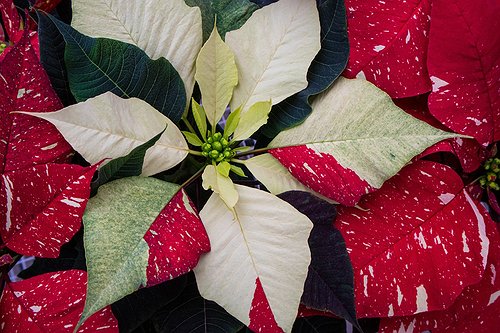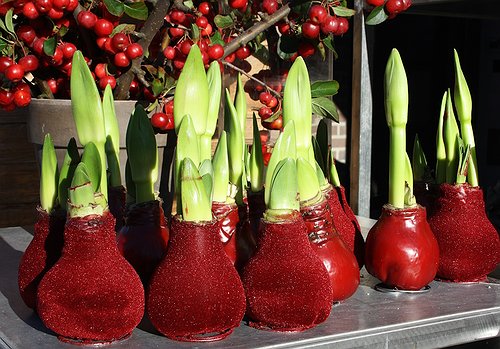Keep Holiday Houseplants Thriving and Blooming
CANDACE GODWIN/Contributing writer | Coeur d'Alene Press | UPDATED 1 year, 12 months AGO
The cheerful blooms of a poinsettia, Christmas cactus, or amaryllis add a touch of magic to holiday decorating and can brighten even the grayest of winter days. Unfortunately, many of these plants are discarded when the holiday decorations come down.
However, with a little care, you can keep your holiday houseplants thriving well after the holiday season and even have them rebloom.
Poinsettias
When you think of Christmas, it’s hard not to think of poinsettias. According to the website Random Acts of Flowers, more than 35 million potted poinsettias are sold every year in the U.S. This accounts for almost one quarter of all potted plants sold.
There is a misconception that poinsettias are poisonous; they are not. However, if you have pets with a tendency to chew houseplants, you should keep them out of reach, as could cause some stomach upset.
The poinsettia is a native plant of Mexico and was first associated with Christmas during the 1600s when Franciscan priests living in southern Mexico used the colorful leaves to decorate their extravagant nativity scenes.
What we typically think of as the poinsettia “flower” is actually a group of bracts or modified leaves, which look like flower petals. The real flowers of the plant are the tiny, yellow blossoms in the center of the leaf bracts, called cyathia.
As daylight begins to shorten the poinsettia begin to bloom and the green bracts turn color. Red is still the predominate poinsettia color, but with 100+ varieties, colors can range from deep burgundy to pinks and creams. Some have speckled or variegated leaves in candy cane colors.
To keep your poinsettia looking its best through the holidays, place it near a window where it will receive bright daylight and consistent temperatures of 65 to 70 degrees. Light from an east- or south-facing window is best. Avoid placing your plant where temperatures fluctuate, drop below 55 degrees, or in locations that are overly drying, such as near heat vents or fireplaces.
As a tropical plant, poinsettias grow well in a moist environment. Water when the soil surface feels dry or when the container feels light. Keep the soil moist, not soggy. Poinsettia don’t like to sit in excess water.
After the holidays, transplant your poinsettia to a larger container with good drainage in a quality potting. A monthly feeding with an all-purpose plant fertilizer or fish emulsion will keep your plant growing strong.
To rebloom for the next holiday season, the plant will require 14 hours of uninterrupted darkness when fall arrives. Beginning in early October, keep your plant in a sunny location during the day, but place it in a closet or cover it with a box for the long 14-hour night. This will encourage the plant to begin reblooming just in time for the holiday season.
Amaryllis
Perhaps the most stunning holiday houseplant is the amaryllis with its huge, trumpet shaped flowers. True amaryllis are a native plant of South Africa, however, the bulbs available today are native to Central and South America in the genus Hippeastrum.
Amaryllis blossoms can be anywhere from 4 to 10 inches across in a single or double bloom. Popular holiday colors include red and white, but amaryllis flowers can vary from shades of rose, salmon, and apricot to dark burgundy. Some flowers are bicolored or may have petals edged in contrasting colors.
Amaryllis are easy to grow and can be purchased as bare bulbs, waxed bulbs, or kits that container everything you need to grow. When choosing bare or waxed bulbs, look for the largest, as these will produce the biggest flowers.
Choose a container that is just a bit wider than the bulb and fill it with a quality potting mix that contains peat or coir. Place the bulb so it sits above the container’s edge. Then cover the bulb about halfway with soil, leaving the top exposed.
Water thoroughly and allow it to drain completely (doing this in the sink is a good idea). Then place the bulb in a sunny window. Water when the top 2 inches of the soil feels dry, but avoid over-watering or leaving the plant in standing water.
Once the flower buds begin to open, move the plant out of direct sunlight and enjoy its beauty! After the flowers have faded, cut off the spent blooms to prevent seed formation, but leave the flower stalk. When the stalk turns yellow cut it off, but don’t remove the leaves. Place the plant back in a sunny window.
Unlike other types of bulbs, amaryllis don’t require a rest or dormant period to rebloom. Fertilize your plant once a month with a houseplant fertilizer that is high is phosphorus following the manufacturer’s instructions and your plant should rebloom on its own.
Christmas Cactus
There are several types of Schlumbergera, commonly known as Christmas cactus, and each bloom at a different time of the year. Christmas cactus typically bloom in late December or early January; Thanksgiving cactus bloom in early November, and Easter Cactus will bloom in the spring.
Calling these plants cacti is a bit of a misnomer. Unlike desert cacti, which are highly drought resistant, these holiday houseplants are actually succulents. Plants in the Schlumbergera family grow in tree branches in the tropical rainforests of Brazil. Given their natural habitat, they require lots of water to thrive.
Christmas cacti prefer bright light and temperatures around 68 degrees, especially when they are blooming. They prefer a humid environment, so a regular misting of water is better than over-watering. Placing a few pebbles in the bottom of a plant saucer can also help to add humidity.
Water when the soil is dry to the touch and don’t let the soil get water-logged or allow the plant to stand in water.
Once the blooms fade, fertilize the plant once a month through the summer with a water-soluble houseplant fertilizer. When the temperatures warm up in the spring, you can move your plants outside to an area that receives dappled shade. To promote branching and more flowers, pinch back the stems in early June.
About six to eight weeks before you want your cactus to re-bloom, force dormancy by cutting back on water and reducing light and the temperature. To rebloom, the plants require 12 to 14 hours of darkness each day and a cool, 50-degree environment.
New flower buds will begin to appear within 3 to 4 weeks of dormancy. Once the buds are set, you can move the plant back into bright light and enjoy the lovely blooms!
Holiday houseplants are a beautiful gift to give or receive during the festive season, and with a little care, can last for many years to come.
Candace Godwin is a certified Idaho Master Gardener and the owner of The Coeur d’Alene Coop (thecoeurdalenecoop.com), a blog on gardening and raising backyard chickens.







